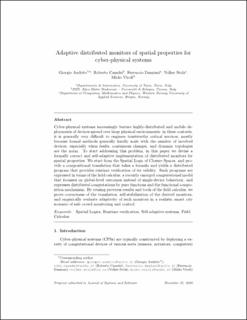| dc.description.abstract | Cyber–physical systems increasingly feature highly-distributed and mobile deployments of devices spread over large physical environments: in these contexts, it is generally very difficult to engineer trustworthy critical services, mostly because formal methods generally hardly scale with the number of involved devices, especially when faults, continuous changes, and dynamic topologies are the norm. To start addressing this problem, in this paper we devise a formally correct and self-adaptive implementation of distributed monitors for spatial properties. We start from the Spatial Logic of Closure Spaces, and provide a compositional translation that takes a formula and yields a distributed program that provides runtime verification of its validity. Such programs are expressed in terms of the field calculus, a recently emerged computational model that focusses on global-level outcomes instead of single-device behaviour, and expresses distributed computations by pure functions and the functional composition mechanism. By reusing previous results and tools of the field calculus, we prove correctness of the translation, self-stabilisation of the derived monitors, and empirically evaluate adaptivity of such monitors in a realistic smart city scenario of safe crowd monitoring and control. | en_US |
